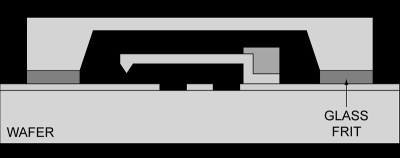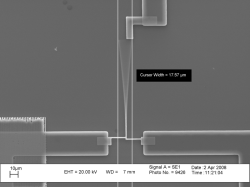What’s tiny and on track to be worth $22 billion dollars by 2018? MEMS (Micro Electrical Mechanical Systems). That’s a catch-all phrase for microscopic devices that have moving parts. Usually, the component sizes range from 0.1 mm to 0.001 mm, which is tiny, indeed. There are some researchers working with even smaller components, sometimes referenced as NEMS (Nano Electrical Mechanical Systems).

Cantilever
In mechanical engineering, a cantilever is a rigid structure, often a beam or a plate, anchored at one end to a support. Any load applied to the cantilever transmits to the support. This is often used when building bridges, for example.

It is relatively straightforward to detect acceleration using a cantilever. First, you attach a microscopic proof mass to the end. Acceleration will cause that mass to move, thus stressing the cantilever. By measuring the stress on the support, you can determine the amount of acceleration force on the cantilever. By positioning cantilevers on different axes, you can read acceleration in each direction.
History
While the term itself dates back to 1986, the idea is much older. In 1959, for example, Richard Feynman lectured about the possibility of such devices. However, practical construction using semiconductor manufacturing techniques made the devices theoretical for a long time.
Even so, Feynman’s lecture anticipated a few key points to MEMS and even created two challenges. One was to construct a tiny motor and was completed using conventional tools in 1960. The other challenge had to wait until 1985 when a graduate student reduced a passage of text to be 25,000 times smaller.
Unfortunately, Feynman was ahead of his time, and building a tiny motor conventionally didn’t really advance the state of the art. One of Feynman’s key points that you could make a set of remote manipulators at, say, quarter-scale. Then you could use those manipulators to build another set at 1/16th scale and keep repeating the process. Feynman knew that you’d eventually have to change how the manipulators work because materials behave differently at scale and forces that act on things get funny as the scale goes down, too.
Future
Of course, the cantilever is just one possible device. There are MEMS temperature sensors, magnetic field sensors, radiation sensors, and more. There are microscopic motors that use electrostatic force instead of electromagnetic, micro gas valves, and optical switches.
Because the MEMS devices use semiconductor fabrication techniques, it is inviting to integrate them with conventional circuits. We are already starting to see microcontrollers with MEMS devices onboard and we expect to see that trend continue.
By the way, we covered a video done by [Engineer Guy] on this topic awhile back. You can watch it, below.
Banner image via Stanford’s QCN quake-detecting network.
















What we might see when all of it’s done is an entire laboratory on a chip.
aka “TricorderTM”
Considering the poor state of medicine in third-world countries, diagnostic equipment wouldn’t have to be shrunk that small to reap a lot of benefits.
and reducing size does not always mean reducing costs, at least not at the beginning of developpment/production.
Also the problem is probably not always (only) the equipment but also the people with knowledge. Even here in the European Union in a “first world” country you often have to wait months to get an appointment with a specialised doctor. :-/
Or the warlord taking all of it and leaving people to starve or die in the streets during a civil war. A smaller thermometer isn’t going to solve that one.
“Even here in the European Union in a “first world” country you often have to wait months to get an appointment with a specialised doctor. :-/”
The problem there is not the availability of technology; it’s the widespread infection of socialism. That can be overcome by the availability of freedom and capitalism.
@Backwoods Engineer
If you are joking it is a good one, a good imitation of a fool spouting crap he obviously have no idea about.
If not you really should try to remove your head from your ass – if anything socialism increases the possibilities of people becoming specialists. Availability of inexpensive education is the first step in increasing the availability of specialized services.
Uhm. iCorder? These things nearly always wind up with a brand name.
yes, but many of the microfluidic devices that have been developed are in some ways too small for their own good and easily get blocked up with even the tiniest amount of dust or other particulate matter, they usually need a bit more sample preparation/filtration.
http://www.prnewswire.com/news-releases/timex-and-silmach-to-disrupt-watch-industry-by-inventing-first-mems-technology-movement-300478288.html
A MEMS watch.
http://www.silicon.co.uk/workspace/scottish-scientists-develop-worlds-smallest-antenna-95001?inf_by=595147b6681db8ca278b4a7d
RF-MEMS.
Another thing about MEMS and why the military pursues it is immunity to EMP.
Good article! There are a few mistakes though.
“On the right, you can see a microscopic cantilever vibrating in resonance.” – The image is on the left.
“There are microscopic motors that electrostatic force instead of […]” – missing “use”?
Here the picture is on the right… Maybe you are on the other side of the earth or something like this? ;-)
For the second image where that statement is found? The first image (Resonant Cantilever) is on the right, the second (Cantilever Cross Section) is on the left.
Yeah you are correct, my mistake, sorry, didn’t read correctly.
Conclusion: The image is right but on the left. (<– supposed to be a joke…)
yes but “there’s a bathroom on the right” ….thats from a song ;)
Cool article, for example MEMS microphones started as papers and reserch are, then included in high priced, hig ended devices, but now we can play with them
http://s.click.aliexpress.com/e/F66qNbu
How long to wait for the mext MEMS breakout-able component
How long to wait until you (Absolutelyautomation with new name) stops spamming???
I remembered when there were memory cards that used MEMS technology to get what was then an unprecedented 8GB in a single card. Of course, it didn’t take long for Flash to catch up and regain the lead…
So when will the first MEMS 3D printer be released? :/